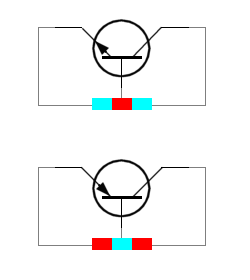Bipolar Transistors


Figure 1: Arrangement of the semiconductor material in a transistor


Figure 1: Arrangement of the semiconductor material in a transistor
There are many different types of bipolar transistors but their basic theory of operation is all the same. As a matter of fact, the theory we will be using to explain the operation of a transistor is the same theory used earlier with the pn-junction diode except that now two such junctions are required to form the three elements of a transistor. The three elements of the two-junction transistor are
- the emitter, which gives off, or „emits”, current carriers (electrons or holes);
- the base, which controls the flow of current carriers; and
- the collector, which collects the current carriers.
Classification
Transistors are classified as either npn or pnp according to the arrangement of their n and p materials. Their basic construction and chemical treatment is implied by their names, „npn” or „pnp”. That is, an npn transistor is formed by introducing a thin region of p-type material between two regions of n-type material. On the other hand, a pnp transistor is formed by introducing a thin region of n-type material between two regions of p-type material. Transistors constructed in this manner have two pn junctions, as shown in figure 1. One pn junction is between the emitter and the base; the other pn junction is between the collector and the base. The two junctions share one section of semiconductor material so that the bipolar transistor actually consists of three elements.

Figure 2: Circuit symbols for transistors

Figure 2: Circuit symbols for transistors
Since the majority and minority current carriers are different for n and p materials, it stands to reason that the internal operation of the npn and pnp transistors will also be different. The theory of operation of the npn and pnp transistors will be discussed separately in the next few paragraphs. Any additional information about the pn junction will be given as the theory of transistor operation is developed.
To prepare you for the forthcoming information, the two basic types of transistors along with their circuit symbols are shown in figure 2. It should be noted that the two symbols are different. The horizontal line represents the base, the angular line with the arrow on it represents the emitter, and the other angular line represents the collector. The direction of the arrow on the emitter distinguishes the npn from the pnp transistor. If the arrow points in, (points in) the transistor is a pnp. On the other hand if the arrow points out, the transistor is an npn (not pointing in).
Another point you should keep in mind is that the arrow always points in the direction of hole flow, or from the p to n sections, no matter whether the p section is the emitter or base. On the other hand, electron flow is always toward or against the arrow, just like in the junction diode.
Construction
The very first transistors were known as point-contact transistors. Their construction is similar to the construction of the point-contact diode. The difference, of course, is that the point-contact transistor has two p or n regions formed instead of one. Each of the two regions constitutes an electrode (element) of the transistor. One is named the emitter and the other is named the collector, as shown in figure 3, view A.

Figure 3: Basic design of transistors

Figure 3: Basic design of transistors

Figure 3: Basic design of transistors
Point-contact transistors are now practically obsolete. They have been replaced by junction transistors, which are superior to point-contact transistors in nearly all respects. The junction transistor generates less noise, handles more power, provides higher current and voltage gains, and can be mass-produced more cheaply than the point-contact transistor. Junction transistors are manufactured in much the same manner as the pn junction diode discussed earlier. However, when the pnp or npn material is grown (view B), the impurity mixing process must be reversed twice to obtain the two junctions required in a transistor. Likewise, when the alloy-junction (view C) or the diffused-junction (view D) process is used, two junctions must also be created within the crystal.
Although there are numerous ways to manufacture transistors, one of the most important parts of any manufacturing process is quality control. Without good quality control, many transistors would prove unreliable because the construction and processing of a transistor govern its thermal ratings, stability, and electrical characteristics. Even though there are many variations in the transistor manufacturing processes, certain structural techniques, which yield good reliability and long life, are common to all processes:
- Wire leads are connected to each semiconductor electrode;
- the crystal is specially mounted to protect it against mechanical damage; and
- the unit is sealed to prevent harmful contamination of the crystal.

